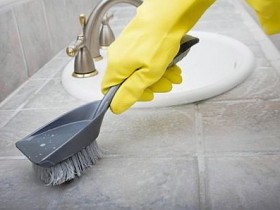- Types of polymeric sealants for bathroom
- Sealant for bath, which is better?
- How to apply sealant to the bath?
- A cheaper way to protect the bathroom
- Removal of sealant to the bath surface
- How to prevent fungus and mold in the bathroom
- Technology toe sealing tape
- Sealing of water pipes in the bathroom
You can not dispute the fact, that is always in the bathroom humidity, since it is connected with the specifics of the premises. The warm and moist environment creates favorable conditions for the growth of microorganisms, which contribute to the destruction of building materials and lead to the formation of mold. Even a good bathroom ventilation is not able to block all the way microbial growth, Only careful insulation of all seams and joints using a sealant, containing substance destroying the microorganisms, It will allow you to close the problem.
Types of polymeric sealants for bathroom
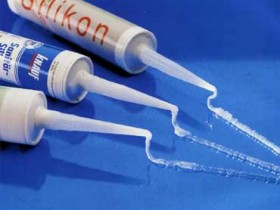
A good silicone sealant - is not afraid to temperature changes - from 50 to + 200 degrees Celsius. A good adhesion to most materials, neutral to the UFO and has a long life to 40 years old.
Acidic silicone sealant can not be used with metals, can be neutral, but its price is more expensive.
Acrylic - may be resistant to moisture and nevlagostoykim, seam sealant from this lack of elasticity. undoubtedly, moisture-resistant is more suited to the bathroom, he finally hardens within a day, as well as silicone is not afraid to temperature and ultraviolet irradiation.
Best sealant for bath - silicone-acrylic, aquarium it is as elastic and durable, as polymers of which it is made. Moreover, it as a silicone sealant is applied in the gluing surfaces and unmatched for durability and elasticity.
PUR - good adhesion to materials, the seam of it elastic and durable, is not afraid of mechanical influences. It responds well to painting, time for drying of the sealant 8 hours at odnomilimetrovoy thickness.
Sealant for bath, which is better?
Feedback from buyers for the bathroom more suitable sealants with fungicide inclusions, which prevents mold and well resist moisture and temperature changes. the details of Choosing a good sealant for Bath.
Keep in mind that even a special silicone sealant with very frequent contact with water, about a year starts to blacken.
Solution to the problem. Cut with a knife the old structure and filled with new.
Basic requirements for sealants for bathrooms :
- Resistance to mold:
- Nerastekayuschayasya pasty consistency;
- High adhesion to different materials.
Not to be mistaken with a choice of simply. To do this, should I buy the products of the famous brands, company with a serious reputation and hope for a good consumer reviews
Protection of all connecting surfaces in the room to the bathroom gives us a guarantee against leakage of water on the floor and inside walls, will protect neighbors from below flood.
But certainly better to use grout or set border.
Small joints in the bathroom, width up to 0,5 see provided that firmly zakrepliny surface and along the perimeter to seal recommended fugue - tile grout. The grout can be pre-stir the paint, which is suitable for the lining color. Vodostoykaya gap, Used for grouting tiles in swimming pools, most suitable, as a material to protect all available connecting surfaces in the bath. To rust did not spoil the color of the Fugue, additionally treated with a special joint brilliant composition. When the bottom of the room to the bathroom tiled, Here also it is necessary to apply for the same sealing grout.
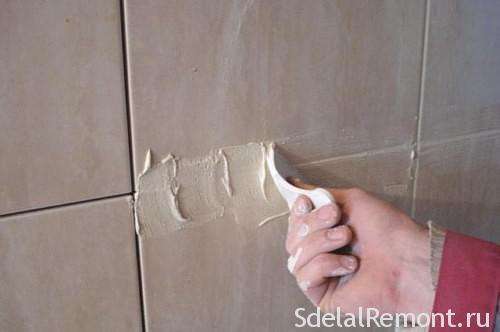
The gaps in the bathroom best suited to close their silicone acrylic sealant resistant to water. This sealant for acrylic baths allows you to eliminate the gap to one and a half centimeters in width.
Packaging for it may be a tube or cartridge, color selected according to your taste, the cartridge will need a special gun. Sealants for the pistol far superior, than being in a tube.
How to apply sealant to the bath?
Sealant butt on the bath, try to adhere to the following instructions:
- Clear the bath from dirt and moisture, then we dry it and the wall, located around.
- degreasing joints, to be sealed.
- Paste the masking tape, to determine the boundaries of the seam and make it even.
- Cut away the tip of the cartridge or tube at a certain angle, of which will depend on joint width.
- Squeezing the pistol grip or pushing the tube impose uniform motion smooth seam on seam bathroom with walls.
- To align the seam, lowering the finger in a soap solution, We hold them for docking connections.
In that case, if the distance is large enough, to 3 cm, it is embedded in ceramic baseboards. Ways to accomplish this, there are three:
- buy special ceramic borders and use them as plinths;
- if you left the material, which was used to cover the walls of the bathroom, it will be the best option for ceramic tiles;
- the most time consuming way - to his own cut of tile desired sample.
first, it is recommended, if the gap is large, seal the joint with foam polyurethane. then you can, making cement-sand mortar, to lay tile, trying to keep the angle 45 degrees. Even better would be, if you're in the same way it is able to publish the junction of walls and floors in the bathroom.
A cheaper way to protect the bathroom
There is a cheaper way to protect the bathroom - using plastic skirting boards or the corners of plastic with rubber edges, they should be put on the glue "liquid nails". Property of elasticity of the plastic material makes it possible to differentiate the bath base shifts, are possible when it travels. Pre-treat all joints with silicone, then close the corners. If the corners recede, waterproof sealant will block the way forward water.
You can use masking tape to protect the seam in the bathroom. The tape is manufactured of different widths, but it should be to glue observing recommendations, otherwise it will not last long. To avoid this, it is necessary to use glue "liquid nails", or silicone sealant.
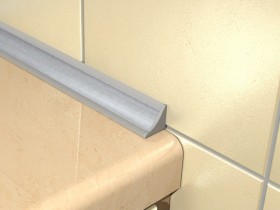
If this kind of work needs to be done in a bath with hardwood floors, you can use a special sealer for wood. He performs optimally compensatory action at the expense of high-net-expansion coefficient.
Removal of sealant to the bath surface
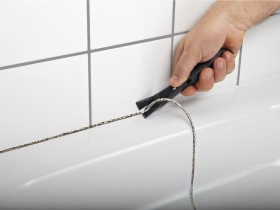
Before working for the protection of the bathroom, sometimes had to remove old sealant, or clean the bath of the new, but the dried silicone. To remove the sealant from bath should use a sharp scraper and brush. Podobrav slope skrebka, sharp and rapid hand movements cut away the old sealant, brush and sweep away remote silicone pieces.
Clear sealant bath may be using white spirit, but there is a danger of damage to the product, and if it was painted, it will act together with silicone and paint.
Foam-840 is another matter, It is used for removing sealant from bath. With this silicone composition is completely destroyed and does not damage the product. When, When the film remains on the product, it is recommended to remove acetic acid.
How to prevent fungus and mold in the bathroom
The first measure when it detects small raw spots - is the processing of hydrogen peroxide or vinegar. When you have found a fungus on the sealant in the bathroom to get rid of this trouble, you need:
- ventilate the room, opening the windows completely and it is desirable to have a "hinged" plastic windows;
- bathroom not close, to leave a gap for, to equalize the humidity and temperature;
- infested surfaces with a special tool to the concrete or masonry.
When you see mold on the sealant in the bathroom, You can use folk remedies:
Place treat creosote or solution in ten liters of water with one kilogram of copper sulfate, or 1,5 kg sodium fluoride, as a solution, consisting of a pound of copper sulfate and two liters of acetic acid for ten liters of water.
Technology toe sealing tape
Sealing tape bathroom is available in different widths and a variety of colors. When choosing ribbon border is necessary to consider, that its width should be at least 10 mm higher than the slot width. It is better not to save, and lane set larger.
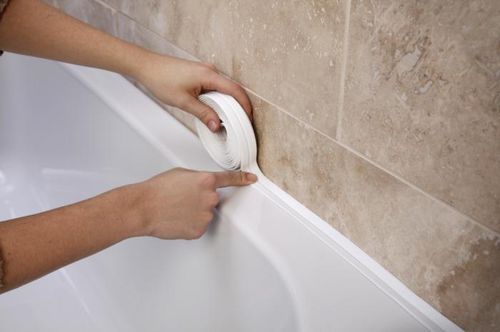
The seal is attached on the following technology:
surface preparation: cleaning, degreasing and drying.
Cutting the ribbon to three overlapping strips to the side members by 1,5 cm.
Bending the curb along the length of incisions.
Push-tape self-adhesive to the joint.
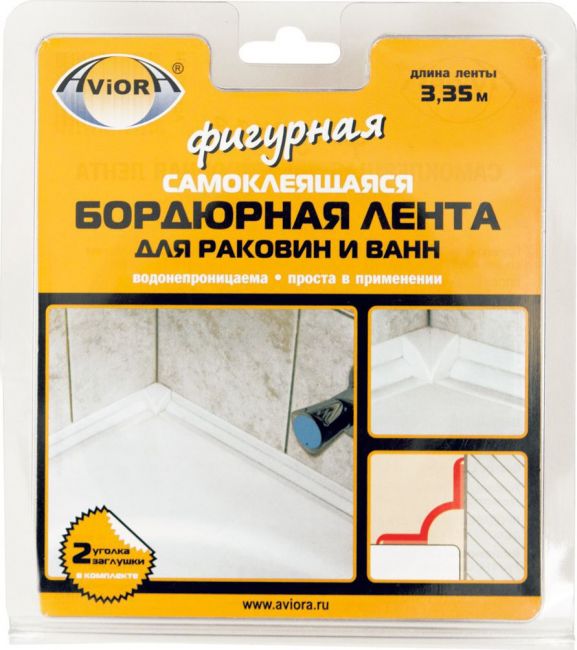
Sealing of water pipes in the bathroom
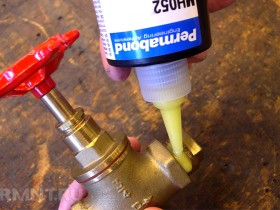
When sealing of the bath can not be forgotten, about the work to eliminate leaks of pipes water supply and sanitation, who are in this room. In this case a special silicone sealant for sewer pipes of two types - acidic and neutral. Recent suited to all surfaces and aquatic environments, first not suitable for interaction with acids. Silicone sealant is used not only for sealing of plastic pipes, but also proved to be excellent sewer pipes made of cast iron.
Sanitary sealants are used in bathrooms, which possess high adgeziynymi properties and are used in the protection of joints in between the walls and plumbing.
The same type includes plumbing sealant tubes, which serves to protect the individual elements of conduits. they are designed, to maintain a high level of protection of tightness, both at low, and at a high pressure, and provide good sealing under high temperature conditions in pipe joints.

